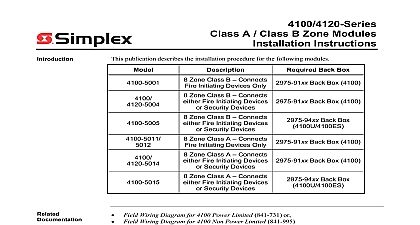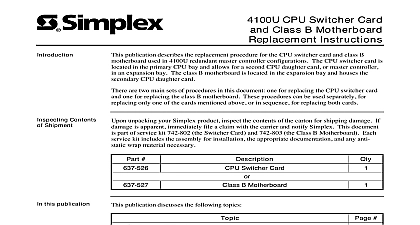Simplex Replace Instructions CPU Switcher Card Class B Motherboard

File Preview
Click below to download for free
Click below to download for free
File Data
| Name | simplex-replace-instructions-cpu-switcher-card-class-b-motherboard-4326519708.pdf |
|---|---|
| Type | |
| Size | 769.37 KB |
| Downloads |
Text Preview
Introduction Contents Shipment Switcher Card Class B Motherboard Instructions publication describes the replacement procedure for the CPU switcher card and class B used in 4100U and 4100ES redundant master controller configurations The CPU card is located in the primary CPU bay and allows for a second CPU daughter card or controller in an expansion bay The class B motherboard is located in the expansion bay houses the secondary CPU daughter card are two main sets of procedures in this document one for replacing the CPU switcher card one for replacing the class B motherboard These procedures can be used separately for only one of the cards mentioned above or in sequence for replacing both cards unpacking your Simplex product inspect the contents of the carton for shipping damage If is apparent immediately file a claim with the carrier and notify Simplex This document part of service kit 742 802 the Switcher Card and 742 803 the Class B Motherboard Each kit includes the assembly for installation the appropriate documentation and any anti wrap material necessary Switcher Card B Motherboard this publication publication discusses the following topics and Warnings the CPU Switcher Card the Class B Motherboard 2001 2011 SimplexGrinnell LP All rights reserved and other information shown were current as of publication and are subject to change without notice and the Simplex logo are trademarks of Tyco International Ltd and its affiliates and are used under license B and Warnings and AND SAVE THESE INSTRUCTIONS Follow the instructions in this installation These instructions must be followed to avoid damage to this product and associated Product operation and reliability depend upon proper installation NOT INSTALL ANY SIMPLEX PRODUCT THAT APPEARS DAMAGED Upon your Simplex product inspect the contents of the carton for shipping damage If is apparent immediately file a claim with the carrier and notify an authorized product supplier HAZARD Disconnect electrical field power when making any internal adjust or repairs All repairs should be performed by a representative or authorized agent of local Simplex product supplier HAZARD Static electricity can damage components Handle as follows yourself before opening or installing components to installation keep components wrapped in anti static material at all times SAFETY HAZARD Under certain fiber optic application conditions the optical output this device may exceed eye safety limits Do not use magnification such as a microscope other focusing equipment when viewing the output of this device RULES AND REGULATIONS PART 15 This equipment has been tested and found to with the limits for a Class A digital device pursuant to Part 15 of the FCC Rules limits are designed to provide reasonable protection against harmful interference when equipment is operated in a commercial environment This equipment generates uses and radiate radio frequency energy and if not installed and used in accordance with the manual may cause harmful interference to radio communications Operation of equipment in a residential area is likely to cause harmful interference in which case the will be required to correct the interference at his own expense REACCEPTANCE TEST AFTER SOFTWARE CHANGES To ensure proper system this product must be tested in accordance with NFPA 72 after any programming or change in site specific software Reacceptance testing is required after any addition or deletion of system components or after any modification repair or to system hardware or wiring components circuits system operations or software functions known to be affected by a must be 100 tested In addition to ensure that other operations are not affected at least 10 of initiating devices that are not directly affected by the up to a maximum of 50 devices must also be tested and proper system operation 72 is a registered trademark of the National Fire Protection Association the CPU Switcher Card CPU switcher card is used in redundant master controller configurations to automatically the communications bus and city circuit from a primary CPU card to a backup secondary card when a trouble is detected by the 24 point I O card The CPU switcher card is located the Primary CPU Bay the top bay in the back box card layout within the Primary CPU Bay is different than that of a normal CPU bay The motherboard and daughter card for instance are installed at the far left of the bay rather the right Also the network card slot on the CPU motherboard must not be used in redundant controller configurations Immediately to the right of the primary CPU motherboard is the Switcher Card and then the 24 point I O card Figure 1 shows a sample layout of a Primary bay within a 4100U 4100ES configured with a redundant master controller the switcher card involves removing system power detaching the two connectors from card at P3 and P4 and removing the four Torx screws that fasten the board to the standoffs at rear of the bay However because the switcher card is mounted in between other cards in the the CPU motherboard must also be removed to make it possible for the switcher card to be from the adjacent cards Motherboard Card Slot used Daughter Card Controller Switcher Point I O Supply or 1 Primary CPU Bay Layout Power and the Primary Bay Disconnect any connection to the batteries at the PDM and then remove the power to the at the breaker Lower the front door to the Primary CPU Bay the top bay in a redundant master controller panel Refer to Figure 1 for the location of the CPU switcher card and CPU within the bay on next page the CPU Switcher Card Continued the CPU CPU motherboard must be removed from the bay before the CPU switcher card can be Follow the steps below to remove the CPU motherboard from the Primary CPU Bay Label and detach the service port and front display ribbon cables from the CPU daughter card is mounted to the CPU motherboard The service port cable is the thinner of the two cables Release and lower the card stabilizer at the front of the bay by pressing in the tabs at either of the stabilizer The card stabilizer must be lowered before cards can be removed Pull the CPU daughter card out of its slot on the CPU motherboard and set it aside next few steps involve the labeling and removal of cables connected to the CPU You will be reattaching these cables later The locations and suggested labels the connections are shown in Figure 2 Label and disconnect any plug connected to P1 on the CPU motherboard Label and disconnect any plugs connected to P4 P5 or P6 Label and disconnect any plugs connected to P7 and P8 Label and disconnect any wires connected to TB3 Include as part of the label the name of the block and the specific terminal the wire connects to Label and disconnect any wires connected to the eight position terminal block Include as of the label the name of the terminal block and the specific terminal the wire connects to TB2 used see note TB2 the RUI terminal on the motherboard is not in redundant master configurations use 567 217 RUI TB3 Net 232 TB1 2 CPU Motherboard Connection Labels on next page the CPU Switcher Card Continued the CPU Remove the six Torx screws that fasten the motherboard to the standoffs at the rear of the bay and set them aside for later use The location of each screw is shown in Figure 3 the Existing Switcher Card 3 CPU Motherboard Screw Locations Leave the standoffs fastened to the rear of the CPU bay You will attach the replacement to these same standoffs Disconnect the J1 header connector on the CPU motherboard from the P1 header connector the CPU switcher card to completely detach the CPU motherboard Set the board aside You will reinstall it after the new CPU swi


